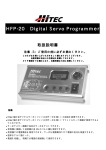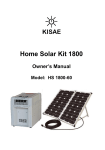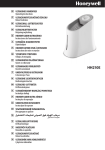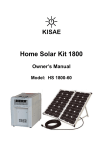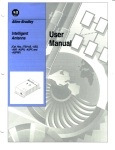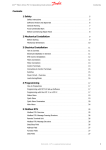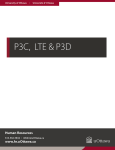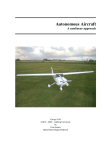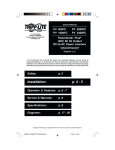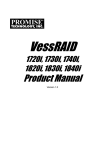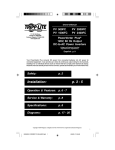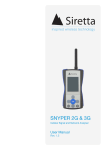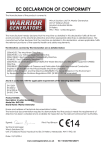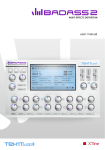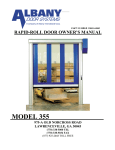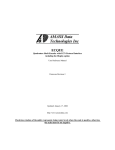Download User`s Manual AeroPerfect Digital Incidence & Control Throw Meter
Transcript
AeroPerfect- User's Manual Page 1 of 36 User's Manual AeroPerfect Digital Incidence & Control Throw Meter Aileron Setup Page 2 Elevator Setup Page 4 Rudder Setup Page 6 Setting Incidence Page 8 Degree Conversion Page 11 Programming Hitec Servos Page 12 Setting Up Level Page 23 Frequently Asked Questions Page 25 Specifications Page 28 AeroPerfect Warranty Page 36 file://C:\My Documents\Airplane RC\AeroPerfect Website\aeroperfect_users_manual.html 3/26/2007 AeroPerfect- User's Manual Page 2 of 36 Aileron Setup Setting A Zero Reference Measuring Up Deflection Measuring Down Deflection The AeroPerfect Digital Control Throw Meter makes setting up your aileron throws a cinch! In the following example, the aileron control throws are setup for +/- 22.35 degrees. If your aircraft's control throws are specified in inches or millimeters, these numbers are easily converted to degrees. Please refer to the Degree Conversion Page in this user's manual. Make sure your aircraft is held so it can't move around. You can make your own cradle or there are a number of commercially available cradles you can use. Adjust your aircraft's position so that the aileron's hinge line is reasonably level (eyeball is fine). Step 1: Adjust your aileron linkages as you normally would. Move the aileron to its neutral position. You can either employ a method of mechanically clamping the aileron at neutral or use your radio and servo to hold it in position. Step 2: Either hand hold or clamp the MU-1800-I to the aileron so that the edge of the measuring plate is near the hinge line and parallel to it. Place your AP3 Digital Display where you can view it while you make control throw adjustments. Simply push the RESET button on the AP3 Digital Display to set a zero reference angle. Step 3: Push your radio's stick fully to the left and then fully to the right while using your AeroPerfect to measure the control throw angles. Obtain the desired file://C:\My Documents\Airplane RC\AeroPerfect Website\aeroperfect_users_manual.html 3/26/2007 AeroPerfect- User's Manual Page 3 of 36 control throw angles either by adjusting your radio's EPA's, or mechanically adjusting your linkages. If you plan to program Hitec Digital Servos to obtain your control throws, please see the Hitec Digital Servo Programming Page in this user's manual. (Step 4) Since it "remembers" the zero from the first aileron, matching control throws for the second aileron is easy with the AeroPerfect ! Being careful to not disturb the position of your aircraft, hand hold or clamp the MU-1800-I to the other aileron and adjust your linkages until the AP3 reads zero. (Make sure you orient the MU-1800-I in the same direction as with the first aileron- in other words, don't rotate the MU-1800-I 180 degrees with respect to the hinge line). Repeat step 3. file://C:\My Documents\Airplane RC\AeroPerfect Website\aeroperfect_users_manual.html 3/26/2007 AeroPerfect- User's Manual Page 4 of 36 Elevator Setup Setting A Zero Reference Measuring Up Deflection Measuring Down Deflection The AeroPerfect Digital Control Throw Meter makes setting your elevator control throws a cinch! In the following example, a left elevator half is setup for +/- 9.55 degrees. If your aircraft's control throws are specified in inches or millimeters, these numbers are easily converted to degrees. Please refer to our Degree Conversion Page in this user's manual. Make sure your aircraft is held so it can't move around. You can make your own cradle or there are a number of commercially available cradles you can use. Adjust your aircraft's position so the elevator(s)are reasonably level (eyeball is fine). Step 1: Adjust your elevator linkages as you normally would. Move the elevator to its neutral position. You can either employ a method of mechanically clamping the elevator at neutral or use your radio and servo to hold it in position. Step 2: Either hand hold or clamp your AeroPerfect Digital Control Throw Meter to the elevator so that the edge of the measuring plate is near the hinge line and parallel to it. It is best to make your measurement as close to the fuselage as is practical. Place your AP3 Digital Display where you can view it while you make control throw adjustments. (In order to get the AeroPerfect AP3 into the photo, it is clamped to a music stand, but you can place it anywhere within a 6 foot radius from the MU-1800-I for easy viewing!) Simply push the RESET button on the AP3 Digital Display to set file://C:\My Documents\Airplane RC\AeroPerfect Website\aeroperfect_users_manual.html 3/26/2007 AeroPerfect- User's Manual Page 5 of 36 a zero reference angle. Step 3: Pull your radio's stick fully toward you and then fully away from you while using your AeroPerfect to measure the control throw angles. Obtain the desired control throw angles either by adjusting your radio's EPA's, or mechanically adjusting your linkages. If you plan to program Hitec Digital Servos to obtain your control throws, please see the Hitec Digital Servo Programming Page in this user's manual. (Optional Step 4) Since it "remembers" the zero from the first elevator half, matching elevator halves is easy with the AeroPerfect ! Being careful to not disturb the position of your aircraft, simply hand hold or clamp the MU-1800-I to the other elevator half and adjust your linkages until the AP3 reads zero. (Make sure you orient the MU-1800-I in the same direction as with the first elevator half- in other words, don't rotate the MU-1800-I 180 degrees with respect to the hinge line). Repeat step 3. file://C:\My Documents\Airplane RC\AeroPerfect Website\aeroperfect_users_manual.html 3/26/2007 AeroPerfect- User's Manual Page 6 of 36 Rudder Setup Setting A Zero Reference Measuring Right Deflection Measuring Left Deflection The AeroPerfect Digital Control Throw Meter makes setting up your rudder throws a cinch! In the following example, the rudder control throws are setup for +/- 28.65 degrees. If your aircraft's control throws are specified in inches or millimeters, these numbers are easily converted to degrees. Please refer to our Degree Conversion Page in this user's manual. Make sure your aircraft is held so it can't move around. You can make your own cradle or there are a number of commercially available cradles you can use. Adjust your aircraft's position so that the rudder's hinge line is reasonably level (eyeball is fine). Step 1: Adjust your rudder linkages as you normally would. If your rudder will be driven by two servos, make sure you attach only the linkages associated with the servo you're setting up. Move the rudder to its neutral position. You can either employ a method of mechanically clamping the rudder at neutral or use your radio and servo to hold it in position. Step 2: Either hand hold or clamp the MU-1800-I to the rudder so that the edge of the measuring plate is near the hinge line and parallel to it. Place your AP3 Digital Display where you can view it while you make control throw adjustments. (In order to get the AeroPerfect AP3 into the photo, it is clamped to a music stand, but you can place it anywhere within a 6 foot radius from the MU-1800-I for easy viewing!) Simply push the RESET button on the AP3 Digital Display to set a zero reference angle. file://C:\My Documents\Airplane RC\AeroPerfect Website\aeroperfect_users_manual.html 3/26/2007 AeroPerfect- User's Manual Page 7 of 36 Step 3: Push your radio's stick fully to the left and then fully to the right while using your AeroPerfect to measure the control throw angles. Obtain the desired control throw angles either by adjusting your radio's EPA's, or mechanically adjusting your linkages. If you plan to program Hitec Digital Servos to obtain your control throws, please see the Hitec Digital Servo Programming Page in this user's manual. (Optional Step 4) Setting up your control throws using a second rudder servo is easy with the AeroPerfect. Unclamp and temporarily remove the MU-1800-I from the rudder. Rotate your aircraft axially 180 degrees so that the opposite side of the rudder is facing up. Adjust your aircraft's position so that the hinge line is reasonably level (again, eyeball is good enough). Disconnect the linkage from the servo you setup in steps 1 - 3. (Optional Step 5) Adjust the rudder linkage for this servo exactly as you did the first one. Move the rudder to its neutral position. As in step 1, employ a method of holding the rudder at neutral in preparation for the next step. Again, as in step 2, either hand hold or clamp your MU-1800-I to the rudder so that the edge of the measuring plate is near the hinge line and parallel to it. Push the RESET button on the AP3 Digital Display to set a zero reference angle. (Optional Step 6) Repeat the procedure used in step 3 for setting up the rudder control throws associated with this servo and its linkage. Once you get the same control throws for this servo and its linkages, (make sure they're operating in the correct direction before proceeding) you can connect the linkages associated with the first servo. Again, if you plan to program Hitec Digital Servos to obtain your control throws, please see the Hitec Digital Servo Programming Page in this user's manual. Since two digital servos are operating one control surface, it is recommended that you adjust the deadbands on both servos to be the same (and perhaps a bit wider than default). Use the AeroPerfect to verify the control throws with both servos operating. file://C:\My Documents\Airplane RC\AeroPerfect Website\aeroperfect_users_manual.html 3/26/2007 AeroPerfect- User's Manual Page 8 of 36 Setting Incidence Measuring angles of incidence and/or decalage with your AeroPerfect Digital Control Throw Meter is a breeze! First, just a bit of background: The angle of incidence of the airplane's wing is the angular measurement between a reference line on the plane's fuselage (sometimes called FRL for "Fuselage Reference Line" or WL for "Water Line") and the wing's chord. The wing's chord, by definition, runs through the wing's cross section from the center of the leading edge to the tip of the trailing edge. The same also applies to the angle of incidence of the airplane's horizontal stabilizer. It is the angular measurement between the FRL and the horizontal stabilizer's chord. Decalage (deka-laj) is a word of French origin and refers to the angular difference between the wing's chord and the horizontal stabilizer's chord and does not reference the FRL or WL line. Positive decalage means that the wing is at a more nose-up angle than the tail. As an example, if the wing has an incidence of one degree leading edge up and the tail an incidence of one degree leading edge down (or "negative one degree"), there is a decalage of positive two degrees. If the wing is mounted with an incidence of positive five degrees and the tail with an incidence of positive three degrees, the decalage is still two degrees positive. Measurement Preparations In order to measure decalage or incidence, you will need to hold your aircraft securely in place and level the wings (an eyeball estimate is all that is required). An incidence clamp is required in order to get a reference line that is parallel to the wing chord. You can build your own or use one of the several commercially available ones. Measuring Decalage Step 1: Turn your radio and receiver on and adjust the elevator for zero deflection. Simply secure the incidence clamp to the stabilizer and hold the MU-1800I's measuring plate onto the top of the crossbar. Push the RESET button on the AP3 Digital Display to set a zero reference angle. file://C:\My Documents\Airplane RC\AeroPerfect Website\aeroperfect_users_manual.html 3/26/2007 AeroPerfect- User's Manual Page 9 of 36 Setting A Zero Reference -.60 Degrees Negative Decalage Step 2: Remove the incidence clamp from the stabilizer. If it's necessary for the clamp to be on the aileron, use the aileron servo to hold zero deflection. Secure the incidence clamp to the wing. Again, hold the MU-1800-I's measuring plate onto the top of the crossbar. Maintain the original zero-set orientation. Read the decalage angle directly from the AP3 Digital Display. In the above photos, you'll notice that the wing's chord is slightly more "nose down" than the elevator's chord. Measuring Incidence The method for measuring Incidence is fundamentally the same as for measuring decalage, except the AeroPerfect's zero reference angle is set at the FRL (or WL). Step 1: Identify the FRL (or WL) and hold the edge of the MU-1800-I's measuring plate parallel to it. For example, let's assume the FRL is parallel to the top portion of the fuselage where the canopy would go. Place the MU-1800-I's measuring plate onto the top portion of the fuselage as shown. Push the RESET button on the AP3 Digital Display to set a zero reference angle. file://C:\My Documents\Airplane RC\AeroPerfect Website\aeroperfect_users_manual.html 3/26/2007 AeroPerfect- User's Manual Page 10 of 36 Setting A Zero Reference on the FRL -.10 Degrees Incidence From FRL .50 Degrees Incidence From FRL Wing's Angle of Incidence Step 2: Secure the incidence clamp to the wing. Hold the MU-1800-I's measuring plate onto the top of the crossbar. Maintain the original zero-set orientation. Read the wing's angle of incidence in relation to the FRL directly from the AP3 Digital Display. Stabilizer's Angle of Incidence Step 3: With the elevator servo holding zero, secure the incidence clamp to the stabilizer. Hold the MU-1800-I's measuring plate onto the top of the crossbar. Again, maintain the original zero-set orientation. Read the stabilizer's angle of incidence in relation to the FRL directly from the AP3 Digital Display. You can see that the difference between the two incidences (the wing's incidence in relation to the FRL and the stabilizer's incidence in relation to the FRL) is .60 degrees. This is exactly what we measured for the decalage. Obviously, if you're interested in measuring decalage, it is best to use the method described under "Measuring Decalage" because it only requires two measurements instead of three. Take note of where you obtain your zero angle references and notice whether the angles are moving positive or negative. file://C:\My Documents\Airplane RC\AeroPerfect Website\aeroperfect_users_manual.html 3/26/2007 AeroPerfect- User's Manual Page 11 of 36 Degree Conversion The control throws on many aircraft models are specified in inches or millimeters. Not to worry- these values are easily converted to degrees! All you need to know is the control throw distance (as specified in your model's instructions) and the width (chord) of the control surface at the point where the control throw distance is specified, again, referring to your model's instructions. Commonly, control throws are specified at the widest part of the control surface (the widest where the measurement line is perpendicular to the hinge line). Knowing the point where the control throw distance is specified is only important if the control surface is tapered and does not have a constant chord. Otherwise, the control throw can be measured (or specified) anywhere along the length of the control surface. You can download a Conversion Utility Spreadsheet from the AeroPerfect Website at http://www.aeroperfect.com/deflection_conversion.xls. You can "right-click" and select "save target as" or "save link as", depending on your browser. If your control throws are expressed as a fraction (e.g., 1-5/16), simply enter "1", then a space, and then "5/16". The spreadsheet will convert it to a decimal number. Alternatively, you can divide the deflection which has been expressed in inches by the control surface width (also expressed in inches). Then, take the result and push the arcsine button on your calculator. Be sure to use the same units for the deflection and width. file://C:\My Documents\Airplane RC\AeroPerfect Website\aeroperfect_users_manual.html 3/26/2007 AeroPerfect- User's Manual Page 12 of 36 Programming Hitec Servos Bench Program Your Servo Because of its high degree of accuracy, the AeroPerfect Digital Control Throw Meter is extremely useful when programming Hitec Digital servos. We at Bell Electronic Technologies have developed two methods for programming Hitec Digital servos using the AeroPerfect Digital Control Throw Meter: One that is adapted for "on the bench" and one for "on the plane". The following procedure describes the "on the bench" method. By using the following procedure, you can bench program your Hitec digital servos using the Hitec HFP-10 programmer without resorting to the "trial and error" method. (We are not in any way affiliated with Hitec. We just wanted to share with you a method that has worked for us!) Please read our Conditions Of Use below. Please use the Servo Calibration Spreadsheet along with this procedure. The spreadsheet is available at http://www.AeroPerfect.com/offplane_cal.xls. Downloading of this spreadsheet indicates that you agree with the Conditions of Use below. You can either "right-click" and select "save target as" or "save link as", depending on your browser. In the following example, a Hitec HS-5645MG is programmed with the Hitec HFP-10 digital servo programmer. The AeroPerfect Digital Control Throw Meter is used to accurately measure the angle of the servo arm. The initial values in the spreadsheet were obtained while using an Eclipse 7 radio with EPA's set to 115%. Programming Overview This procedure takes into account the difference (if any) between your radio's pulse widths and the pulse widths assumed by the HFP-10 programmer for all radios and calculates an appropriate ratio. A preliminary set of calibration numbers are obtained from the HFP-10 programmer based on this ratio. These numbers are tested by using your radio and accurately measuring the servo arm angles with your AeroPerfect Digital Control Throw Meter. The final programming numbers are then calculated by the spreadsheet based on the measured angles. Before we get started, we'd like to say a word about about the direction of rotation. CW (clockwise) and CCW (counter-clockwise) is mentioned in two file://C:\My Documents\Airplane RC\AeroPerfect Website\aeroperfect_users_manual.html 3/26/2007 AeroPerfect- User's Manual Page 13 of 36 contexts within this procedure: One describes which direction the servo arm is rotating, while the other refers to the direction programmed by the HFP-10 (Program CW/CCW). If you program your servo for CW (clockwise servo rotation) using the HFP10, it means that wider pulse widths will cause CW servo rotation. (Conversely, narrower pulse widths will cause CCW servo rotation). Also, if you program your servo for CCW (counter-clockwise servo rotation) using the HFP-10, it means that wider pulse widths will cause CCW servo rotation. (Conversely, narrower pulse widths will cause CW servo rotation). On our Eclipse 7 radio (with all of the channels set to "normal" NOT "rev") we've observed that, with the servo directions set to "normal", that left stick movement produces narrower pulse widths and down stick movement also produces narrower pulse widths (and the converse of this is true as well). Let's get started! Program Your Radio Step 1: Set the trims and sub-trims on all channels of your transmitter to zero and make sure the EPA adjustments are where you plan to use them (e.g., 100% or 115%) for all channels. Also, make sure you don't have any mixes activated. (There is an advantage in setting your EPA's near your radio's maximum in order to gain resolution. You can even set your radio's EPA's to maximum, however if you end up needing a greater control throw range, the servo would have to be reprogrammed.) Set the direction for the radio channel you plan to use to "Normal". Measure Your Radio's Pulse Widths Step 2: Connect the HFP-10 to the radio channel you plan to use. Select the Measure Pulse program function. With the control stick at neutral, enter the number of microseconds into the spreadsheet on the "Measure Radio's Pulse Widths" row and in the "Middle" column. Move your radio's control stick in the direction that will yield the smallest pulse width and enter that value into the spreadsheet on the same row, but in the "CW Degrees" column. Lastly, move your radio's control stick in the direction that will yield the largest pulse width and enter that value into the "CCW Degrees" column. file://C:\My Documents\Airplane RC\AeroPerfect Website\aeroperfect_users_manual.html 3/26/2007 AeroPerfect- User's Manual Page 14 of 36 At this point, the spreadsheet shows two scale factors that will be used later to obtain the "Initial Program Numbers". Test Fixture Step 3: In order to bench program your Hitec Digital servo, you'll need to make a test fixture. The test fixture is extremely simple since we won't be needing protractors, tape, machined arms, or pointers. Simply attach one of the many extra plastic arms you have lying around to a flat piece of wood as shown below. Not shown in picture, but C-clamping the flat piece of wood to the workbench is recommended. Test Fixture Arm Mounting Detail 1 Test Fixture Arm Mounting Detail 2 Servo Mounted in Test Fixture Servo Mounted in Test Fixture 2 Overview of Test Setup Overview of Test Setup Initial Spreadsheet Values Step 4: Reset the servo using the Program Reset function on the HFP-10. After resetting the servo, make sure you set the desired direction of of servo rotation using the Program cw/ccw function at this time. Please refer to the CW - CCW discussion above in deciding the direction of rotation. file://C:\My Documents\Airplane RC\AeroPerfect Website\aeroperfect_users_manual.html 3/26/2007 AeroPerfect- User's Manual Page 15 of 36 Enter the direction of rotation and the desired angular range into the spreadsheet. Install Servo Into Test Fixture Establish A Zero Step 5: Set the HFP-10 to the S-Test Manual program function and set the knob for the number of microseconds that you measured for neutral in step 2 (Probably somewhere close to 1500 microseconds). Push the servo shaft into the plastic servo arm of the test fixture so that the servo case is as parallel to the test fixture servo arm as it can be. Rotate the knob on the HFP-10 so that the servo case is at your desired zero angle (where you want the servo arm to be in relation to the servo case). Hold one end of the MU-1800-I measuring plate onto the servo case and obtain a zero angle reference by pushing the reset button on the AeroPerfect AP3 display (Please utilize the measurement plate for this step rather than placing the MU-1800-I directly onto the servo case without the plate. This will prevent any interaction between the MU-1800-I damping circuit and the servo). Obtaining Initial Programming Numbers Step 6: Select the Program EPAneuFS program function. In preparation for the next few steps, here are a few more photos that provide an overview of the test setup: Step 7 Step 8 Step 9 file://C:\My Documents\Airplane RC\AeroPerfect Website\aeroperfect_users_manual.html 3/26/2007 AeroPerfect- User's Manual Page 16 of 36 Step 7: Hold the measuring plate of the AeroPerfect MU-1800-I onto the servo case and rotate the HFP-10's knob until you reach zero on the AeroPerfect AP3 display (photo is incorrect and should be showing zero here). Enter the initial program number from the HFP-10 display into the spreadsheet under the "(M)" column and on the "Initial Program Numbers" row. Push the "M" button on the HFP-10. Step 8: Continue to hold the measuring plate of the AeroPerfect MU-1800-I onto the servo case and rotate the HFP-10's knob left until the AeroPerfect AP3 display reads the calculated value from the spreadsheet on the "Initial Numbers Based On" row (and under the "CW Degrees Column"). Enter the initial program number from the HFP-10 display into the spreadsheet under the "UP/L" column (and on the "Initial Program Numbers" row). Press the UP/L button. Step 9: Continue to hold the measuring plate of the AeroPerfect MU-1800-I onto the servo case and rotate the HFP-10's knob right until the AeroPerfect AP3 display reads the calculated value from the spreadsheet on the "Initial Numbers Based On" row (and under the "CCW Degrees Column"). Enter the initial program number from the HFP-10 display into the spreadsheet under the "DN/R" column (and on the "Initial Program Numbers" row). Press the DN/R button. Measure the Error Step 10: Disconnect the servo from the HFP-10 and connect it to your receiver. Holding the AeroPerfect MU-1800-I measuring plate as described previously, measure the angles of the servo case as you move the radio's stick from neutral, to full left and full right. Enter the angular values into the spreadsheet on the "Measured Angles Using Radio" row. Be sure to enter the values in either the "CW Degrees" or the "CCW Degrees" column, depending on which way the servo case is rotating (not whether the AeroPerfect AP3 is displaying a positive or negative number). For your radio's neutral stick position, take note of any error from zero. If the error you measured is that the servo arm is too far CW (Clockwise), file://C:\My Documents\Airplane RC\AeroPerfect Website\aeroperfect_users_manual.html 3/26/2007 AeroPerfect- User's Manual Page 17 of 36 enter a positive number into the spreadsheet. Otherwise, if the error you measured is that the servo arm is too far CCW (Counter-clockwise), enter a negative number into the spreadsheet. Again, use the "Measured Angles Using Radio" row and the "Middle" column. Program the Final Calibration Numbers Step 11: The spreadsheet now has the final calibration numbers. Use the Program EPAneuFS program function to program the "Predicted Numbers" from the spreadsheet. Rotate the knob until the predicted number for "M" shows on the HFP-10 display. Push M. Then rotate the knob left until the predicted number for "UP/L" shows on the display. Push UP/L. Rotate the knob right until the predicted number for "DN/R" shows on the display. Push DN/R. Make Final Control Throw Measurements Step 12: Disconnect the servo from the HFP-10 and connect the servo to your radio receiver. Use the AeroPerfect MU-1800-I as before to measure your desired zero angle and to verify the servo case rotation in both directions. You have now successfully bench programmed your Hitec digital servo using your AeroPerfect Digital Control Throw Meter ! You may want to print out the spreadsheet at this time for future reference. Servo Programming: "On Your Aircraft" Here is the second servo calibration procedure developed by Bell Electronic Technologies. It is adapted to programming a Hitec digital servo while on the plane. The AeroPerfect Digital Control Throw Meter is perfectly suited for this because of its high degree of accuracy and ease of use. This method will allow you to program your Hitec digital servos using their Hitec HFP-10 programmer without resorting to the "trial and error" method. (Again, we are not in any way affiliated with Hitec. But this just works too well to keep it to ourselves!) Please read our Conditions of Use Below. Programming Overview As in the "Bench Program Your Servo", a preliminary set of calibration file://C:\My Documents\Airplane RC\AeroPerfect Website\aeroperfect_users_manual.html 3/26/2007 AeroPerfect- User's Manual Page 18 of 36 numbers are obtained from the HFP-10 programmer. A set of estimated calibration numbers are obtained by multipling the preliminary set of numbers by a scale factor. The scale factor is calculated based on the ratio between your radio's actual pulse widths and the HFP-10 programmer's assumed pulse widths for all radios. Your AeroPerfect Digital Control Throw Meter is then used to measure your control surface deflection. The final programming numbers are then calculated by the spreadsheet based on the measured error. Please use the following procedure along with the Servo Calibration Spreadsheet. It can be downloaded at http://www.AeroPerfect.com/onplane_cal.xls Downloading of this spreadsheet indicates that you agree with the Conditions of Use below. You can either "right-click" and select "save target as" or "save link as", depending on your browser. In the following example, a Hitec HS-5645MG is programmed with the Hitec HFP-10 digital servo programmer while accurately measuring the control throws with the AeroPerfect Digital Control Throw Meter. As in the previous procedure, it's best to establish a convention as it relates to pulse widths and CW - CCW: If you program your servo for CW (clockwise servo rotation) using the HFP-10, it means that wider pulse widths will cause CW servo rotation. (Conversely, narrower pulse widths will cause CCW servo rotation). Also, if you program your servo for CCW (counter-clockwise servo rotation) using the HFP-10, it means that wider pulse widths will cause CCW servo rotation. (Conversely, narrower pulse widths will cause CW servo rotation). On our Eclipse 7 radio we've observed that, with the servo directions set to "normal", that left stick movement produces narrower pulse widths and down stick movement also produces narrower pulse widths (and the converse of this is true as well). Prepare Your Transmitter Step 1: Set the trims and sub-trims on all channels of your transmitter to zero and make sure the EPA adjustments are where you plan to use them (e.g., 100% or 115%) for all channels. Also, make sure you don't have any mixes activated. (There is an advantage in setting your EPA's near your radio's maximum in order to gain resolution. You can even set your radio's EPA's to maximum, however if you ever need to increase the control throws, the servo would have to be reprogrammed.) Set the direction for the radio channel you plan to use to "Normal". file://C:\My Documents\Airplane RC\AeroPerfect Website\aeroperfect_users_manual.html 3/26/2007 AeroPerfect- User's Manual Page 19 of 36 Measure Your Radio's Pulse Widths Step 2: Connect the HFP-10 to the radio channel you plan to use. Select the Measure Pulse program function. With the control stick at neutral, enter the number of microseconds into the spreadsheet on the "Measure Radio's Pulse Widths" row and in the "Middle" column. Move your radio's control stick in the direction that will yield the smallest pulse width and enter that value into the spreadsheet on the same row, but in the "CW Degrees" column. Lastly, move your radio's control stick in the direction that will yield the largest pulse width and enter that value into the "CCW Degrees" column. At this point, the spreadsheet shows two scale factors that will be used later to obtain the "Estimated" program numbers. Reset Servo and Install Servo Arm Step 3: Make sure the servo is NOT connected to any control surfaces. Remove any servo arms and reset the servo using the Program Reset function on the HFP-10. After resetting the servo, you may need to reverse the direction of your servo. If so, use the Program cw/ccw function at this time. Please refer to the CW - CCW discussion above in deciding the direction of rotation. Keep in mind that if you need to change the direction of rotation after your servo is programmed, the easiest way is to set the corresponding channel on your radio to "REV". This calibration procedure must be repeated any time the servo direction is changed using the HFP-10's Program cw/ccw function. Step 4: Set the HFP-10 to the S-Test Manual program function and set the knob for the number of microseconds that you measured for neutral in step 2 (Probably somewhere close to 1500 microseconds). Push the servo arm onto the servo shaft 90 degrees to the case (as close as is possible). Make sure you orient it in the desired direction. (Since there are a finite number of spline on the servo arm and shaft, it is possible that the angle between the servo arm and the servo case will not be exactly 90 degrees at this time. However, that will not affect the accuracy of the servo programming.) file://C:\My Documents\Airplane RC\AeroPerfect Website\aeroperfect_users_manual.html 3/26/2007 AeroPerfect- User's Manual Page 20 of 36 Install Servo Into Your Plane Establish a Zero Reference Step 5: If your servo isn't already installed in your aircraft, go ahead and install it and connect the linkage to the servo arm. Rotate the knob of the HFP-10 so that the servo arm is exactly where you want it (probably 90 degrees to the servo case). Mechanically adjust linkages so that the control surface is zero. Establish a zero reference angle by placing the AeroPerfect MU1800-I onto the control surface (that is still set to neutral) and push the reset button on the AeroPerfect AP3 display. Obtain Initial Programming Numbers Step 6: Select the Program EPAneuFS program function. Decide on the range of control throw travel and enter it into the spreadsheet on the "Enter Desired Range" row. Enter the value for both the "CW Degrees" and "CCW Degrees" columns (The CW and CCW values do not have to be the same). Step 7: While holding the AeroPerfect MU-1800-I onto the control surface (the included clamps and plates work well for this), rotate the HFP-10's knob until the control surface reaches its neutral position. Enter the initial program number from the HFP-10 display into the spreadsheet under the "(M)" column and on the "Initial Program Numbers" row. Push the "M" button on the HFP-10. Step 8: Rotate the HFP-10 knob left until the AeroPerfect AP3 display reads the desired angle you entered under the "CW Degrees" column on the spreadsheet on the "Enter Desired Range" row. Enter the initial program number from the HFP-10 display into the spreadsheet under the "UP/L" column (and on the "Initial Program Numbers" row). Press the UP/L button. Step 9: Rotate the HFP-10 knob right until the AeroPerfect AP3 display reads the desired angle you entered under the "CCW Degrees" column on the file://C:\My Documents\Airplane RC\AeroPerfect Website\aeroperfect_users_manual.html 3/26/2007 AeroPerfect- User's Manual Page 21 of 36 spreadsheet on the "Enter Desired Range" row. Enter the initial program number from the HFP-10 display into the spreadsheet under the "DN/R" column (and on the "Initial Program Numbers" row). Press the DN/R button. Program the Estimated Numbers Step 10: The spreadsheet now holds the "Estimated" program numbers which are based on two things: The scale factor between your radio's measured pulse widths and the pulse widths that the HFP-10 assumes for all radios and the initial program numbers you just entered into the spreadsheet. Before proceeding, it is imperative that you disconnect any linkage from the servo arm. Programming the Estimated numbers will require the servo arm to travel farther than it would under normal operation. Use the Program EPAneuFS program function as before to program the "Estimated" numbers into the servo. Measure the Error Step 11: Disconnect the servo from the HFP-10 and connect it to your receiver. Reconnect your servo arm linkage. Use your AeroPerfect Digital Control Throw Meter to measure the control throw deflection for each of the stick positions (neutral, both extremes). Enter the angular values into the spreadsheet on the "Measured Angles Using Radio" row. Be sure to enter the values in either the "CW Degrees" or the "CCW Degrees" column, depending on which direction the servo arm was rotating (not whether the AeroPerfect AP3 is displaying a positive or negative number). For your radio's neutral stick position, take note of any error from zero. If the error you measured is that the servo arm is too far CW (Clockwise), enter a positive number into the spreadsheet. Otherwise, if the error you measured is that the servo arm is too far CCW (Counter-clockwise), enter a negative number into the spreadsheet. Again, use the "Measured Angles Using Radio" row and the "Middle" column. Program the Final Calibration Numbers Step 12: file://C:\My Documents\Airplane RC\AeroPerfect Website\aeroperfect_users_manual.html 3/26/2007 AeroPerfect- User's Manual Page 22 of 36 The spreadsheet now has the final calibration numbers. Use the Program EPAneuFS program function to program the "Predicted Numbers" from the spreadsheet. Before proceeding, it is imperative that you disconnect any linkage from the servo arm. The final calibration numbers will require the servo arm to travel farther than it would under normal operation. Rotate the knob until the predicted number for "M" shows on the HFP-10 display. Push M. Then rotate the knob left until the predicted number for "UP/L" shows on the display. Push UP/L. Rotate the knob right until the predicted number for "DN/R" shows on the display. Push DN/R. Make Final Control Throw Measurements Step 13: Disconnect the servo from the HFP-10 and connect the servo to your radio receiver. Reconnect any servo arm linkage at this time. Use the AeroPerfect MU-1800-I to measure and verify the neutral and the control surface deflection in both directions. You have now successfully programmed your Hitec digital servo using your AeroPerfect Digital Control Throw Meter ! Conditions of Use This calibration procedure and the accompanying servo calibration spreadsheet are provided by Bell Electronic Technologies "as is". In no event shall Bell Electronic Technologies be liable for any direct, indirect, incidental, special, exemplary, or consequential damages arising in any way from the use of this procedure and/or spreadsheet. This procedure and spreadsheet are for private use and may not be used by any other commercial entity. User agrees not to sell this procedure and/or accompanying spreadsheet. User may freely download and distribute this procedure and accompanying spreadsheet as long as these conditions of use are met. User may link to this procedure and/or spreadsheet. Any express or implied warranties, including, but not limited to, the implied warranties of merchantability and fitness for a particular purpose are disclaimed. file://C:\My Documents\Airplane RC\AeroPerfect Website\aeroperfect_users_manual.html 3/26/2007 AeroPerfect- User's Manual Page 23 of 36 Setting Up Level Because the AeroPerfect Digital Control Throw Meter can be set for any zero reference angle, relative measurements can be made on your aircraft without having to reference level (e.g., decalage). However, if desired, the AeroPerfect can also be used as a level. Here are two methods for obtaining level: Method One Step 1: Simply place the MU-1800-I on a flat surface so that the insignia is facing you. Press the AP3 zero button. Step 2: Turn the MU-1800-I 180 degrees (insignia facing away from you) and note the reading on the AP3 Display. Divide that reading in half and write it down. Step 3: Using a few sheets of paper as shims, slip them under the edge of the measuring plate to obtain the number you wrote down at the end of step 2. Press the AP3 Zero Button. You have now calibrated your AeroPefect for level. You can double check the calibration by comparing measurements with the MU-1800-I "insignia facing away" and "insignia facing towards you. You should read the same angle positive (+) as you do negative (-). If the surface on which it sits is truly level, you will read zero in both directions. Method Two Step 1: If you have a level you can trust, simply place the MU-1800-I onto your level. Step 2: file://C:\My Documents\Airplane RC\AeroPerfect Website\aeroperfect_users_manual.html 3/26/2007 AeroPerfect- User's Manual Page 24 of 36 Move your level until it reads level. While holding it at that position press the AP3 Zero Button. You have now calibrated your AeroPefect for level. file://C:\My Documents\Airplane RC\AeroPerfect Website\aeroperfect_users_manual.html 3/26/2007 AeroPerfect- User's Manual Page 25 of 36 Frequently Asked Questions Question: How can I learn about model aircraft safety? Answer: The Academy of Model Aeronautics is an excellent resource for this. Their website can be found here: http://www.modelaircraft.org Question: Can I use the AeroPerfect to measure my rudder deflection? Answer: Yes. Since the AeroPerfect's measuring unit uses gravity as a reference, simply orient your model so that the rudder hinge line is reasonably parallel (eyeball is good enough) to the floor (fuselage on its side) for a perfect measurement. See "Rudder Setup" in this user's manual for details. Question: When I make a control surface measurement, do the hinge lines have to be perfectly level or parallel to the floor? Answer: You can make a perfect measurement without the hinge line being perfectly level. Just an estimate by eye is all that is needed. Question: The control throws for my plane are expressed in inches. How do I convert to degrees? Answer: The conversion utility found here: http://www.aeroperfect.com/degree.html will allow inches to be converted to degrees. You may also divide the deflection which has been expressed in inches by the width (or chord) of the control surface. Then, take the result and push the arcsine button on your calculator. Question: How can I use the AeroPerfect to measure control throws when programming Hitec digital servos? Answer: See the the "Hitec Digital Servo Programming" page of this user's manual for a detailed description. Question: Will the AeroPerfect allow me to match my elevator halves or match my ailerons? Answer: Absolutely! The AeroPerfect is perfectly suited for this. See the "Elevator Setup" and "Aileron Setup" pages in this user's manual for details. file://C:\My Documents\Airplane RC\AeroPerfect Website\aeroperfect_users_manual.html 3/26/2007 AeroPerfect- User's Manual Page 26 of 36 Question: How can I measure wing/stab incidence or decalage with the AeroPerfect? Answer: Most modelers who make these measurements already own an adjustable clamp for this purpose. Simply use your clamp as per its instructions and place the AeroPerfect on the straight surface for making measurements. See the "Setting Incidence" page of this user's manual for details. Question: Does the AeroPerfect have to be in contact with a control surface while it's moving from zero to the plus and minus end points? Answer: There is no need to clamp or hold the AeroPerfect to the control surface while the control surface is moving. Simply hold the AeroPerfect to the surface and set zero, then move the surface to its endpoint and hold the AeroPerfect to the surface and read the angle. Question: I notice that when the AeroPerfect Meter is sitting on a flat surface (after resetting unit to zero) and I then turn it 180 degrees, it appears to show a small error (e.g., 0.3 degrees). Shouldn't the meter read zero? Answer: The table is most likely not perfectly level and your AeroPerfect Meter is measuring the slope of the table. Remember, you do not need to level your table or aircraft before making measurements. If you desire to level your table, please refer to the "Setting Up Level" page in this user's manual for further details about using your AeroPerfect Meter as a precision level. Question: Why are there clamps included with the AeroPerfect? Answer: As an added convenience for adjusting linkages while monitoring the change in angle and in setting a zero. Caution: Do not rapidly operate the control surface while the measuring unit is clamped to it. Question: Is the AeroPerfect compatible with line voltages other than 110VAC? Answer: Yes, the AP12 Power supply accommodates voltages ranging from 90 to 264VAC and 47 to 63Hz which accommodates most international power requirements. Question: I want to make control throw measurements at my airfield. Will the AeroPerfect accept a portable, DC power source? file://C:\My Documents\Airplane RC\AeroPerfect Website\aeroperfect_users_manual.html 3/26/2007 AeroPerfect- User's Manual Page 27 of 36 Answer: Yes. The AeroPerfect AP3 Display accepts a standard, 2.1 millimeter DIN connector whose center conductor is positive such as Hitec Tx Charge leads, part #56375 which have red (positive) and black (negative) banana plugs which can plug into a number of power panels that supply 12 Volts DC (e.g., Tower Hobbies Tower Power Deluxe Power Panel or Hobbico Deluxe Power Panel II). Input voltage range is 7.5 - 30 VDC (+12 Volts, D.C. is nominal). Do not connect battery voltage to the AP3 Display backwards as it will damage the unit. Damage due to application of reverse polarity is not covered under the terms of the Bell Electronic Technologies warranty. Question: Can the AeroPerfect Meter be used as a level? Answer: Yes, it can be used as a precision level. Please refer to the "Setting Up Level" page of this user's manual for details. Question: What if I have a technical question not covered here? Answer: Please contact our technical support department [email protected] if you have additional questions. file://C:\My Documents\Airplane RC\AeroPerfect Website\aeroperfect_users_manual.html at 3/26/2007 AeroPerfect- User's Manual Page 28 of 36 Specifications MU-1800-I Technical Description: The MU-1800-I is a single axis, digital tilt sensor used to report the angle of an object with respect to gravity. Optical shaft encoder technology provides a full +/- 180 (360) degree range. A code wheel and an LED light source comprise the heart of the MU-1800-I. Integral to the MU-1800-I is a weight which is attached to one side of the code wheel assembly causing it to remain stationary with respect to gravity. Internal magnetic damping assures fast response time while eliminating oscillations and ringing. As the housing moves relative to the codewheel, the moving image of radial lines is converted to a real-time digital signal. The MU-1800-I is a non-contacting, rotary to digital converter that converts real-time shaft angle and direction into a digital signal that is displayed on the AP3 front panel. It utilizes an extremely rugged mylar disk, LED light source, metal shaft and high quality ball bearings. The unit is powered by the AP3 digital display unit, and operates on +5VDC. The rotary to digital converter uses a transmissive optical encoder module which has a lensed LED source and a monolithic detector IC enclosed in a small polymer package. The module uses phased array detector technology to provide superior performance and greater tolerances over traditional aperture mask type encoders. file://C:\My Documents\Airplane RC\AeroPerfect Website\aeroperfect_users_manual.html 3/26/2007 AeroPerfect- User's Manual Page 29 of 36 Mechanical Drawings: Front, Back and Side Views Temperature Ratings: Operating Temperature Range Storage Temperature Range Min Max Units Min Max Units -10 +100 Degrees C -40 +100 Degrees C Mechanical Specifications: file://C:\My Documents\Airplane RC\AeroPerfect Website\aeroperfect_users_manual.html 3/26/2007 AeroPerfect- User's Manual Page 30 of 36 Vibration 20 g. 5 to 2KHz Weight 8.47 oz. Damping: The MU-1800-I utilizes eddy-current damping technology. Please refer to the following chart and notice the difference between zero damping and the MU-1800-I damping (angle measurements are obtained immediately and without ringing). AP3 Display Technical Description: The AP3 is a digital LCD readout designed to display the incremental count value of the MU-1800-I. The AP3 features a sign indicator for displaying both positive and negative angles. Signals from the MU-1800-I are filtered to ensure signal integrity over the entire input frequency range. The Match LED illuminates and relay closure occurs when an encoder count equals the zero angle. Under normal operation the relay closure feature is not needed. However the modeler may want to connect an external light or file://C:\My Documents\Airplane RC\AeroPerfect Website\aeroperfect_users_manual.html 3/26/2007 AeroPerfect- User's Manual Page 31 of 36 audio enunciation indicating zero angle has been reached. Please refer to the mechanical drawings and electrical specifications for proper implementation of this feature. Note that any angle reported by the MU1800-I can be reset to a zero reference angle. The AP3 Digital Display is powered by the AP12, +12 Volt power supply (included- see below). Optionally, the display unit accepts power from an external battery through a standard 2.1mm DIN circular plug. (Please see "Frequently Asked Questions" page in this user's manual for further details). The AP3 Digital Display supplies the +5 VDC power for the MU1800-I. Whenever the preprogrammed limits of +/- 0.5 degrees are exceeded, the AP3 digital display illuminates a corresponding High or Low LED. This feature is quite useful since it lets the user know when the angle is approaching zero. The AP3 is constructed of a lightweight high impact polymer case with a clear viewing window. The AP3 display offers 0.5" high digits with blue backlighting. Leading Zero Blanking provides superior readability! (New, October 2006). The AP3 front panel thickness may range up to a maximum of 0.125" thick. Mechanical Drawings: Back and Side Views Panel Cutout Drawing file://C:\My Documents\Airplane RC\AeroPerfect Website\aeroperfect_users_manual.html 3/26/2007 AeroPerfect- User's Manual Page 32 of 36 Installation Instructions: Install in a panel with a thickness of up to 0.125". Cut a rectangle in the panel: 4.79" wide by 2.28" tall. Remove the 4 screws from the rear of the AP3 Carefully pull apart the case. Slide the front section of the display into the panel cutout. Slide the rear cover over the circuitry from the other side of the panel. Re-install the screws. Note: It is very important that care be exercised when opening the case. Do not touch any of the electrical components as static discharge can damage them. Do not force the AP3 into an undersize cutout or over-tighten the screws when reinstalling the case. Damage resulting from improper installation is not covered under the terms of the AeroPerfect Warranty. file://C:\My Documents\Airplane RC\AeroPerfect Website\aeroperfect_users_manual.html 3/26/2007 AeroPerfect- User's Manual Page 33 of 36 Electrical Specifications: Parameter Min. Typ. Max. Units Supply Voltage 7.5 - 30 Volts Supply Current* - - 40 mA Encoder Input Cycle Frequency - - 1.2 MHz Relay Contact Rating*** - - 3.0 Amps Relay Switching Rating**** - - 125 24 VAC VDC Relay Dielectric Stength 500 - - VAC Relay Contact Resistance - - 100 uOhms Enocder Output Voltage** 4.8 5.0 5.2 VDC Encoder Supply Current - - 250 mA Encoder Low Input - 0.4 0.8 VDC Encoder High Input 2.0 5.0 5.75 VDC * Without MU-1800-I attached. ** 100mA load. *** At rated AC or DV voltage. **** An external clamp diode should be used when switching inductive loads. AP-12 Power Supply Description: The AP-12 is an 18W regulated switching power supply that provides 12VDC @ 1.5A output. The power supply covers voltage inputs ranging from 90 to 264VAC and 47 to 63Hz which accommodates most international power requirements. Typical efficiency is 70% and output is short circuit protected. The power supply DC output uses a 2.1mm circular plug (center positive) which is attached to a 48 inch long cable. The power supply plugs directly into a standard 120VAC receptacle. Mechanical Drawing: file://C:\My Documents\Airplane RC\AeroPerfect Website\aeroperfect_users_manual.html 3/26/2007 AeroPerfect- User's Manual Page 34 of 36 file://C:\My Documents\Airplane RC\AeroPerfect Website\aeroperfect_users_manual.html 3/26/2007 AeroPerfect- User's Manual Page 35 of 36 Specifications: Input Voltage 90 to 264VAC Input Frequency 47 to 63Hz AC Plug Type 2-Prong, USA Type, non-polarized Output Voltage 12VDC DC Output Plug 5.5 x 2.1 x 9.5 mm female barrel, center positive Load Regulation ±5% Ripple & Noise 40mV maximum Operating Temperature 0 to 40°C Storage Temperature -30 to 80°C Protections Over voltage, Over current and Short circuit Certification UL 1950, CB (per EN 60950) EMI Meets FCC class "B" AC Input Indicator Green LED Size (inches) 3.15 x 2.16 x 1.26 (WLH) Photograph file://C:\My Documents\Airplane RC\AeroPerfect Website\aeroperfect_users_manual.html 3/26/2007 AeroPerfect- User's Manual Page 36 of 36 AeroPerfect Warranty Bell Electronic Technologies warrants its products against defects in materials and workmanship for two years from shipment. If Bell Electronic Technologies receives notice of such defects during the warranty period, Bell Electronic Technologies will, at its option, either repair or replace products which prove to be defective, or refund the purchase price upon prompt authorized return of the product to Bell Electronic Technologies. Note: This warranty does not apply to defects resulting from: Damage caused by customer, unauthorized modification or misuse, or operation outside Bell Electronic Technologies' published specifications for the product. Under no circumstances will the buyer be entitled to consequential or incidental damages. Bell Electronic Technologies will not be held responsible for damages or losses greater than the cost of the original unit. Flying of model aircraft is a practice that requires a prior knowledge of safe, prudent flying practices and techniques. Bell Electronic Technologies, and/or AeroPerfect.com are not responsible for the education of, or practices by, flyers of model aircraft. The Academy of Model Aeronautics is an excellent resource for learning about model aircraft safety. Their website can be found here: http://www.modelaircraft.org At the discretion of Bell Electronic Technologies, a 15% restocking charge may apply for cancellations or returns unless due to a manufacturing defect. A Return Materials Authorization must be obtained before returning units. Please contact us at [email protected] to obtain return authorization. Returns without an authorized RMA number cannot be accepted. HAPPY FLYING! file://C:\My Documents\Airplane RC\AeroPerfect Website\aeroperfect_users_manual.html 3/26/2007




































